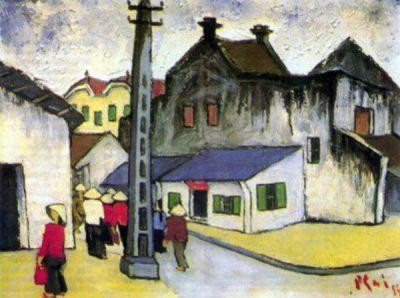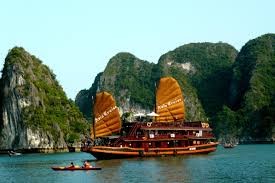A: To begin this week’s edition of the Letter Box, we would like to say hello to Patrick Travers, of South Anston, Sheffield, England.
B: In a letter to VOV dated April 15, Patrick wrote: “I enjoy listening to the Voice of Vietnam programs. I’ve been a regular listener since the 1970s. Thank you for keeping me informed and entertained over the years. It’s a pleasure listening. Please, will you send me one of your Voice of Vietnam pennants or other VOV materials. Please keep me informed by placing my name on your mailing list. I would like to hear more about Vietnamese painters and artists in your broadcasts. I’m also very interested in houses in Vietnam”.
A: Thank you, Patrick, for being a loyal listener to the Voice of Vietnam for such a long time. We really appreciate your listening and your suggestions. Modern Vietnamese art is still young: it came into being in the late 1920s, but it has masters who command respect from connoisseurs, men who have created niches of their own and given Vietnam a place in the world of art.
B: Vietnam's modern art arose between 1925 and 1945 with the establishment of the Indochina Fine Arts College. This college, founded by artists Victor Tadieu and Nam Son, provided an ideal environment for aspiring young artists. There foreign schools of art and prominent artists were studied side by side with traditional Vietnamese art. French and Vietnamese teachers helped the students catch up with the latest art techniques. Many successful artists of Vietnam's early modern art were educated at the Indochina Fine Arts College. Before the founding of the college, there were Vietnamese artists studying in France, but they have remained obscure and their influence has been limited.
A: One master of modern Vietnamese art is Nguyen Phan Chanh, who was credited with making a name for Vietnamese silk painting, outside the shadow of Chinese silk painting. To Ngoc Van was one of the most famous Vietnamese artists, a master of oil painting whose most famous work is Young lady by the lilies. The works of Nguyen Gia Tri, a pioneer in the art of lacquer painting, have become the model of this art form. Tran Van Can was known for his versatility and most famous for his oil paintings and portraits of women. His famous masterpiece is the portrait of his niece called Little Thuy.
B: Other masters of modern Vietnamese art are Nguyen Tu Nghiem, a passionate lover of traditional Vietnamese culture whose works often employ traditional techniques and materials and Bui Xuan Phai, who is most renowned for his paintings of Hanoi's Old Quarter. Most of the works of the early masters of Vietnamese contemporary art are in private collections inside and outside Vietnam.

Hanoi's Old Quarter- Painter: Bui Xuan Phai |
A: Patrick, we hope you and other listeners of VOV with found this brief summary of modern Vietnamese interesting. For more about Vietnamese art, please keep listening to our weekly feature on Vietnamese culture.
B: Last week, we received a lot of letters and emails expressing interest in VOV’s programs, especially the Letter Box segment and especially if they hear their names or answers to their questions.
B: We’re very happy to know this. It encourages us to do our best. This week, we received a letter from Danielle Marie Kopp of Ohio USA. Danielle listened to our program on April 12 from 0231 to 0246 with a good signal on the frequency of 12005 kHz, SINPO rated at 43344. Danielle, thank you for listening. We’ll send you our QSL card.
A: From Sussex England, David Ansell reported listening to our program on April 11 at 1600 UTC on the frequency of 9730 Khz. The reception was fair and SINPO was rated 45433. David wants us to continue these shortwave broadcasts saying he thinks they’re important. Thank you, David. Please expect a letter of confirmation for your listening. It’s on the way.
B: Sanjib Biswas of Kolkata, India is a regular listener to Voice of Vietnam. He wrote: “The half-hour English program is nice and informative. The reception is crystal clear. “News and Current Affairs”, “Mailbag”, and the “Sunday Show” are my favorite radio programs. I would like to know more about the famous sea areas of Vietnam”.
A: Sanjib, thank you for your listening and your interest in learning about our country. Viet Nam has a long coastline that extends along its eastern mainland boundary and wraps around the southern tip for 3,260 km. Its 125 beaches, most of which are beautiful and suitable for tourism, are something not every country has.
B: One of the most famous is at Ha Long Bay, which has been recognized by UNESCO as a World Natural Heritage Site for its beauty and geological interest and is now listed among the new seven natural wonders of the world. Three of Vietnam’s Bays- Ha Long, Nha Trang, and Lang Co- are members of the Exclusive Club of the world’s most beautiful bays.

Ha Long Bay |
A: Other Vietnamese beaches and islands have been honored by news agencies, magazines, and guidebooks. Da Nang Beach was voted by Forbes magazine (USA) one of six most beautiful beaches on the planet in 2005; Bai Dai (Long Beach) on Phu Quoc island was voted one of the world's five best hidden beaches by ABC News in 2008; Con Dao island was named one of the most impressive destinations in Southeast Asia in 2010 by the New York Times magazine. In 2011 Con Dao was listed among the world’s 20 most mysterious islands by Travel and Leisure magazine (USA) and was voted one of the 10 best places in the world to enjoy a romantic holiday by the Lonely Planet travel guide (UK).
A: With its long coastline of thousands of islands near the mainland and the archipelagos of Hoang Sa (Paracel Islands) and Truong Sa (Spratly Islands), sea and island tourism plays an important role in Viet Nam's tourism development strategy.
B: This week we received letters and emails from Howard Barnette of England, who thanked us for sending him VOV’s latest program schedule, our most faithful listener Fumito Hokamura of Japan, John Cooper of the US, who shared his enjoyment in listening to our program, Peter Ng of Malaysia, and Siddhartha Bhattachajee of India.
B: All these listeners sent reports about the English programs they heard and commented on technical issues and program content. We greatly appreciate this feedback. Dear listeners, your reception reports were all complete enough for us to send you letters of confirmation. If your name wasn’t mentioned this week, don’t feel left out. We’ll try to mention you next time.
A: Well, this week’s Letter Box was a little bit longer than usual because took the time to tell you about Vietnam’s modern art and beautiful beaches. But our time is up. Before we go, we’d like to remind you of our address:
The English program,
Overseas Service, Radio Voice of Vietnam,
45 Ba Trieu Street, Hanoi, Vietnam
B: Or you can email us at: englishsection@vov.org.vn. If you miss any of our programs, you can always catch up by logging onto our website at: www.vovworld.vn, where you can hear both live broadcasts and previously recorded programs.